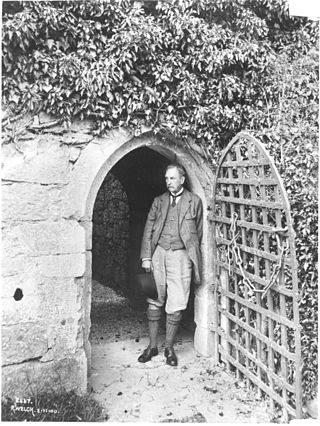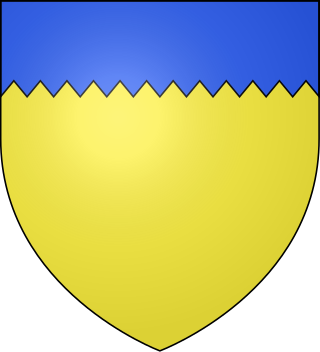
Earl of Longford is a title that has been created twice in the Peerage of Ireland.

Earl Ferrers is a title in the Peerage of Great Britain. It was created in 1711 for Robert Shirley, 14th Baron Ferrers of Chartley. The Shirley family descends from George Shirley of Astwell Castle, Northamptonshire. In 1611 he was created a Baronet, of Staunton Harold in the County of Leicester, in the Baronetage of England. He was succeeded by his son Henry, the second Baronet, who married Lady Dorothy Devereux, daughter of Robert Devereux, 2nd Earl of Essex. On the death of her brother Robert Devereux, 3rd Earl of Essex, she became the youngest co-heir to the baronies of Ferrers of Chartley and the barony of Bourchier, which had fallen into abeyance on the death of the third Earl. Shirley was succeeded by his eldest son, the third Baronet. He died unmarried and was succeeded by his younger brother, the fourth Baronet. He was imprisoned in the Tower of London by Oliver Cromwell and died there in 1656. On his death the title passed to his eldest son, the fifth Baronet. He died at an early age and was succeeded at birth by his posthumous son, the sixth Baronet.

Earl of Kingston is a title in the Peerage of Ireland. It was created in 1768 for Edward King, 1st Viscount Kingston. The Earl holds the subsidiary titles Baron Kingston, of Rockingham in the County of Roscommon, Viscount Kingston, of Kingsborough in the County of Sligo, Baron Erris, of Boyle in the County of Roscommon, and Viscount Lorton, of Boyle in the County of Roscommon, also in the Peerage of Ireland. He is also a baronet in the Baronetage of Ireland. Between 1821 and 1869 the earls also held the title Baron Kingston, of Mitchelstown in the County of Cork, in the Peerage of the United Kingdom.

Viscount Dillon, of Costello-Gallen in the County of Mayo, is a title in the Peerage of Ireland. It was created in 1622 for Theobald Dillon, Lord President of Connaught. The Dillons were a Hiberno-Norman landlord family from the 13th century in a part of County Westmeath called 'Dillon's Country'. His great-grandson, the seventh Viscount, was a supporter of the Catholic King James II of England and was outlawed after the Glorious Revolution. He founded 'Dillon's Regiment' of the Irish Brigade in the French Army, which was supported by the Wild Geese and achieved success at Fontenoy in 1745.

Baron Clonbrock, of Clonbrock in County Galway, was a title in the Peerage of Ireland. It was created on 3 June 1790 for Robert Dillon, who had earlier represented Lanesborough in the Irish House of Commons. His grandson, the third Baron, sat in the House of Lords as an Irish representative peer and served as Lord-Lieutenant of Galway. He was succeeded by his eldest son, the fourth Baron. He was also an Irish Representative Peer and Lord-Lieutenant of Galway. The title became extinct on the death of his son, the fifth Baron, on 1 November 1926.

Theobald Dillon, 7th Viscount Dillon of Costello-Gallin supported King James II, was attainted on 11 May 1691, and fell in the Battle of Aughrim during the Williamite War. His attainder was reversed in favour of the 8th Viscount on 20 June 1694.

Henry Dillon, 8th Viscount Dillon was an Irish soldier and politician. In 1689 he sat in the Patriot Parliament. He fought for the Jacobites during the Wiiliamite War, defending Galway against Ginkel and surrendering it in 1691 after a short siege. He obtained the reversal of his father's attainder in 1696 recovering his father's lands.

Thomas Dillon, 4th Viscount DillonPC (Ire) (1615–1673) held his title for 42 years that saw Strafford's administration, the Irish Rebellion of 1641, the Irish Confederate Wars and the Cromwellian Conquest of Ireland. He was a royalist and supported Strafford and Ormond. He sided with the Confederates for a while but was a moderate who opposed Rinuccini, the papal nuncio.

Theobald Dillon, 1st Viscount Dillon, was an Irish military commander and adventurer. He held extensive lands in eastern Connacht and north-western Leinster, some acquired by sharp practices. He was a loyal supporter of Elizabeth I of England in her Irish wars.
Sir James Dillon was an officer in the armies of the Irish Confederate Catholic during the Irish Confederate Wars (1641–53) and an MP for County Westmeath in the Irish House of Commons. He was likely born at Kilfaughny, Athlone and lived in the vicinity.
Sir James Dillon, 3rd Earl of Roscommon was an Irish magnate and politician. He was born a Catholic but converted at a young age to the Church of Ireland. He supported Strafford during his term as governor of Ireland. In the Confederate Wars and the Cromwellian conquest he was a royalist. He died in 1649, but was nevertheless included as the fifth on the list of people that were excluded from pardon in Cromwell's 1652 Act of Settlement.
Thomas Fleming was an Irish peer, and a member of the Parliament of Ireland of 1585. He was the son of James Fleming, and great-grandson of James Fleming, 7th Baron Slane. His mother was Ismay Dillon, daughter of Sir Bartholomew Dillon, Lord Chief Justice of Ireland and his first wife Elizabeth Barnewall; after his father's death she remarried Sir Thomas Barnewall of Trimlestown.

Butler is the name of a noble family whose members were, for several centuries, prominent in the administration of the Lordship of Ireland and the Kingdom of Ireland. They rose to their highest prominence as Dukes of Ormonde. The family has produced multiple titles such as Baron Cahir, Baron Dunboyne, Viscount Ikerrin, Viscount Galmoye, Viscount Mountgarret, Viscount Thurles, Earl of Carrick, Earl of Kilkenny, Earl of Ormond, Earl of Ossory, Marquess of Ormonde and Duke of Ormonde. Variant spellings of the name include le Boteler and le Botiller. The Butlers were descendants of Anglo-Norman lords who participated in the Norman invasion of Ireland in the 12th century. The surname has its origins in the hereditary office of "Butler (cup-bearer) of Ireland", originating with Theobald Walter, 1st Chief Butler of Ireland. The arms of later family members depicted three cups in recognition of their original office.
Sir Bartholomew Dillon was a leading Irish judge of the sixteenth century who held the offices of Chief Baron of the Irish Exchequer and Lord Justice of Ireland.
Michael James Robert Dillon was the 12th and last Earl of Roscommon.
Thomas Dillon was an Irish judge and landowner: his descendants held the title Baron Clonbrock.
James Dillon, 1st Earl of Roscommon fought for the crown in the Nine Years' War. He was ennobled despite being a Catholic after his son Robert turned Protestant.
Carey or Cary Dillon, 5th Earl of Roscommon, PC (Ire) (1627–1689) was an Irish nobleman and professional soldier of the seventeenth century. He held several court offices under King Charles II and his successor King James II. After the Glorious Revolution he joined the Williamite opposition to James and was in consequence attainted as a traitor by James II's Irish Parliament in 1689. In that year he fought at the Siege of Carrickfergus shortly before his death in November of that year.
Robert Dillon, 2nd Earl of RoscommonPC (Ire) was styled Baron Dillon of Kilkenny-West from 1622 to 1641 and succeeded his father only a year before his own death. He supported Strafford, Lord Deputy of Ireland, who appointed him keeper of the great seal. Dillon was in December 1640 for a short while a lord justice of Ireland together with Sir William Parsons.
Sir Lucas Dillon of Loughglynn (1579–1656) was in 1628 one of the negotiators of the Graces; he was MP for Roscommon in the two Irish Parliaments of Charles I. At the Irish Rebellion of 1641 he sided with the rebels and joined the Irish Catholic Confederation, where he served on the Supreme Council.








